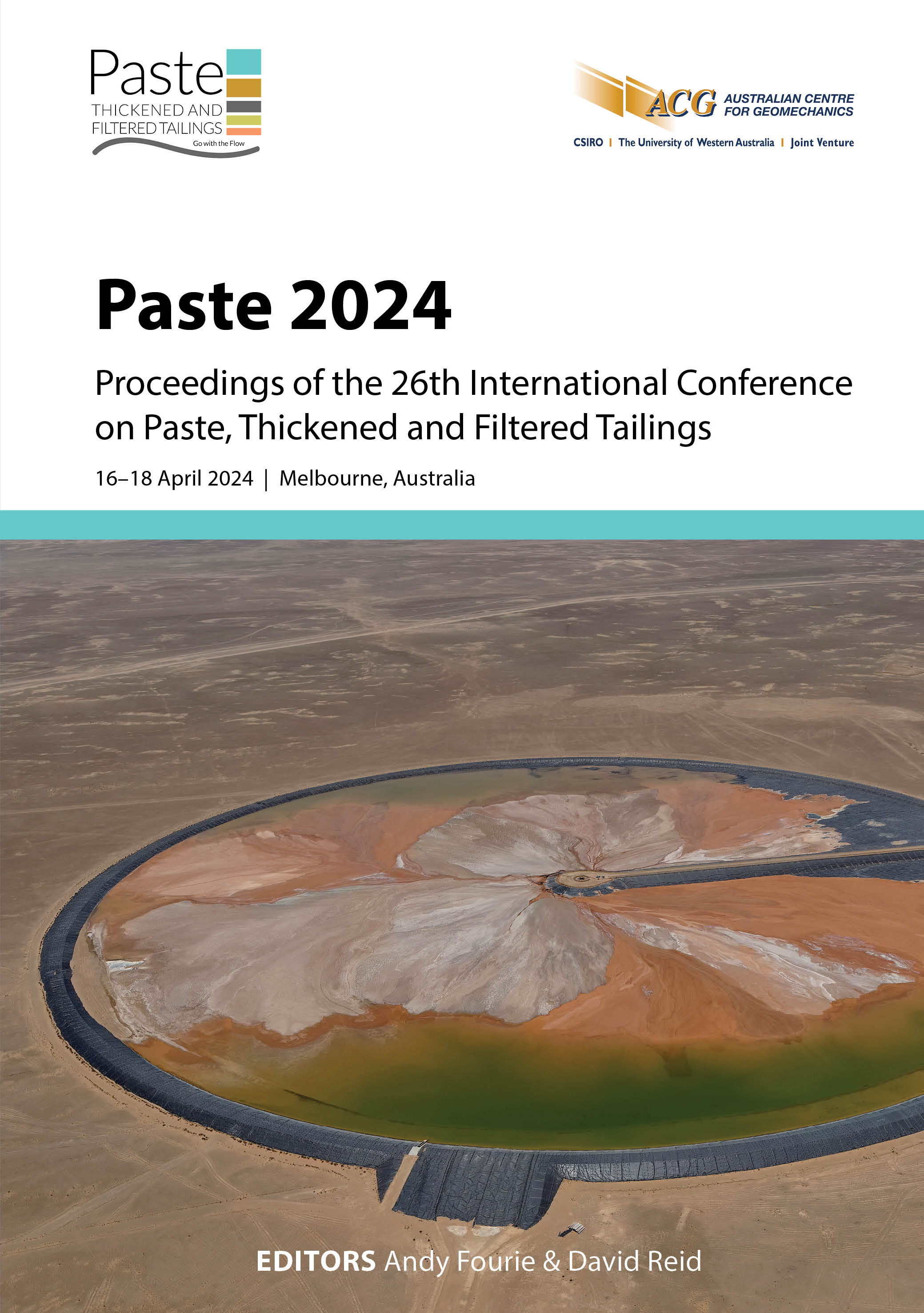Effect of brine, slag and lime inclusion on Fosterville Gold Mine cemented paste backfill strength

|
Authors: Sofrà, F; Felipe, F; Cavalida, R |
DOI https://doi.org/10.36487/ACG_repo/2455_44
Cite As:
Sofrà, F, Felipe, F & Cavalida, R 2024, 'Effect of brine, slag and lime inclusion on Fosterville Gold Mine cemented paste backfill strength', in AB Fourie & D Reid (eds), Paste 2024: Proceedings of the 26th International Conference on Paste, Thickened and Filtered Tailings, Australian Centre for Geomechanics, Perth, pp. 557-570, https://doi.org/10.36487/ACG_repo/2455_44
Abstract:
This paper presents an investigation conducted to evaluate the feasibility of utilising saline water (brine) in cemented paste backfill at Fosterville Gold Mine in Victoria, Australia. The primary motivation for this study arises from sustainability concerns related to the storage of brine generated by the operation’s reverse osmosis (RO) facility. The test work encompasses physical characterisation of tailings, rheological assessments, and strength testing involving various binder and slag combinations. Both brine and raw water are explored as potential diluents. Incorporating brine into binders revealed alterations in yield stress and strength in comparison to the conventional use of raw water, in addition to the long-term strength behaviour related to brine inclusion and binder type and content. Initial increments in slag content within binders corresponded to reduced strength; however, a threshold exists beyond which early strength significantly improves. Higher binder content emerges as a key driver for strength enhancement. Lime use enhances strength particularly when RO brine is employed. General purpose (GP) cement-only binders exhibit strength increments with higher total binder content. Slag and GP cement blend samples display lower early strength but eventually outperform GP cement-only samples, with specific blend compositions demonstrating unique strength profiles at longer curing durations. Test work and operational outcomes underscore the generality (with some exceptions) of unconfined compressive strength improvement with longer curing times, higher total binder content, and increased slag blend content, while highlighting the unique and sometimes inconsistent impact of brine inclusion on the mechanical properties of paste backfill. This test work formed the main basis of Fosterville Gold Mine management to optimise the paste fill mix design to meet the challenging paste backfilling operation requirements while optimising operating cost. Findings provide valuable insights into the prospective utilisation of brine and diverse binder compositions in the Fosterville paste backfill project for more holistic resource management and environmental stewardship.
Keywords: case study, yield stress, paste fill strength, paste fill test work, reverse osmosis brine, binder blends, slag
References:
De Vito, C., Mignardi, S., Ferrini, V & Martin, R. 2011, ‘Reject brines from desalination as possible sources for environmental technologies’, in PRY Ning (ed.), Expanding Issues in Desalination, IntechOpen Limited, London, pp. 85–102.
Mahlaba, JS, Kearsley, EP, Kruger, RA & Pretorius, PC 2011, ‘Evaluation of workability and strength development of fly ash pastes prepared with industrial brines rich in SO42- and Cl− to expand brine utilisation’, Minerals Engineering, vol. 24, no. 10, pp. 1077–1081.
Opong, RW, Nsiah-Baafi, E, Andrews, A & Koomson, B 2022, ‘Preliminary study on the use of reverse osmosis brine and mine tailings as cement paste mixtures for mine backfilling application’, Water, Air, & Soil Pollution, vol. 233, no. 12, p.497.
Stone, D 2014, ‘The evolution of paste for backfill’, in Y Potvin & T Grice (eds), Mine Fill 2014: Proceedings of the Eleventh International Symposium on Mining with Backfill, Australian Centre for Geomechanics, Perth, pp. 31–38.
Nguyen Quoc, D & Boger, DV 1983, ‘Yield stress measurement for concentrated suspensions’, Journal of Rheology, vol. 27, no. 4, pp. 321–349.
Nguyen Quoc, D & Boger, DV 1985, ‘Direct yield stress measurement with the vane method’, Journal of Rheology, vol. 29, no. 3, pp. 335–347.
© Copyright 2025, Australian Centre for Geomechanics (ACG), The University of Western Australia. All rights reserved.
View copyright/legal information
Please direct any queries or error reports to repository-acg@uwa.edu.au
View copyright/legal information
Please direct any queries or error reports to repository-acg@uwa.edu.au
